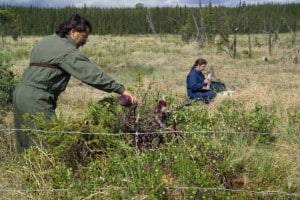http://app.getresponse.com/click.html?x=a62b&lc=jfl9v&mc=IC&s=RrbrmB&u=Yy3s&y=W&


WS member behind first major grizzly estimate of Kenai
By Joshua Rapp Learn
Biologists have scrambled up mountains and searched the remote backcountry of Alaska’s Kenai Peninsula to provide the first comprehensive estimate of the region’s grizzly bear population.
“We’ve been trying to get a Kenai brown bear population estimate for many years now,” said John Morton, a supervisory biologist at the Kenai National Wildlife Refuge and lead author of a new study published in The Journal of Wildlife Management. “It’s a very important benchmark,” said Morton, who is also a member of The Wildlife Society.

John Morton pours blood and fish lure on a fake cache to attract bears while Liz Jozwiak works in the background. Both are biologists at the Kenai National Wildlife Refuge. ©USFWS
The logistics of the study were intense. The team flew crews in two helicopters for 31 consecutive days in June 2010 over 3 million acres of remote backcountry in the Kenai Peninsula.
“Kenai is a pretty rugged and remote area,” Morton said, adding that elevations sometimes went up 6,000 feet from sea level. Some of the traps they deployed in early June on top of snow had moved significantly after melting. “In one instance we looked up and saw it 15 feet up in the trees — that’s how much snow there was.”
They used mark and recapture data compiled from hair snare traps equipped with scented lures of rotten cow blood and barb wire. They repeatedly returned to the traps, taking DNA samples of the individual bears from hair left on the barb wire to see how many bears were in the area.
They extrapolated these numbers to areas they didn’t directly survey and estimated around 600 bears were on the peninsula as a whole in June, 2010.
The number is significant because the Kenai Peninsula is separated from the rest of the state by a 10-mile wide passage of land, meaning much of the wildlife in the area is virtually isolated from outside populations.
The genetic data revealed that the bears in the peninsula aren’t genetically unique enough to constitute a distinct population as defined by USFWS regulations. Morton said the numbers show a healthy population, but worries about the increased hunting levels approved by the state government since 2007, given that the population doesn’t see a lot of outside recruitment.
“Even with the additional births, we’re just hammering the population,” he said.

A camera trap capture of a Kenai brown bear leaving one of 145 barbed-wire hair-sampling stations. ©USFWS
Around 200 bears were known to be killed by humans through intentional harvesting, self-defense or through accidental takes from 2012 to 2014. Accounting for births, Morton said he estimated the population at around 500 individuals on the peninsula today. But the environment of the peninsula is also facing habitat pressure, with increasing development and human population in the area.
Morton said he hopes that the baseline estimates the team made will help inform sound management decisions in the state.
“That’s the impetus to go out there and get this population estimate, to make some science-based decisions,” he said.
| Joshua Rapp Learn is a science writer at The Wildlife Society. Contact him at Joshua.learn@wildlife.org with tips or story suggestions on conservation, wildlife science, management or other story ideas. |


No comments:
Post a Comment